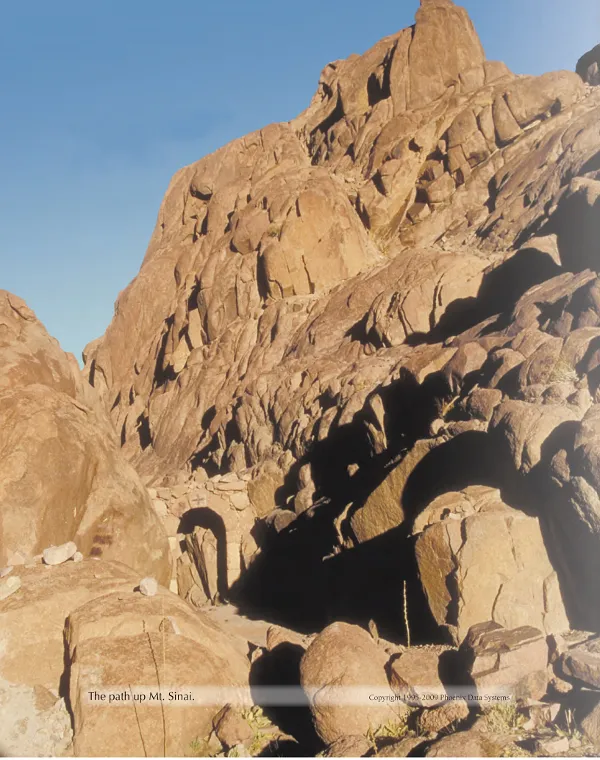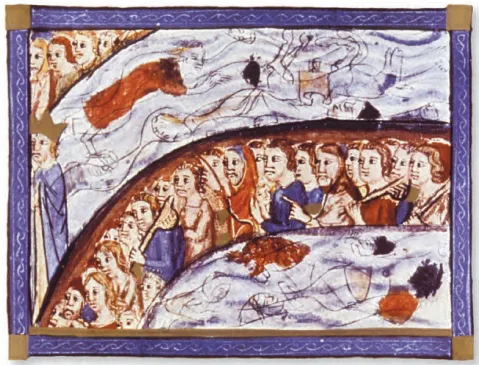CHAPTER 1
APPROACHING THE OLD TESTAMENT
Studying the Old Testament is a monumental task, but proper preparation can help the student to reap a rich harvest. The sovereign God who created the universe, who controls history, and who will accomplish his plan in his time has chosen to speak. That in itself is an act of grace, and we should feel compelled to listen. However, listening may be hindered by many complicating factors. First, God’s revelation did not come in the English language or through Western culture. As a result, we may have to work harder to receive the message clearly. The more familiar students can become with ancient Near Eastern culture, particularly that of Israel during the Old Testament period, the more barriers they can eliminate.
A second complicating factor is that even when we are listening, we have a tendency either to be selective about what we hear or to try to make the message conform to what we want to hear. The solution to this is to allow the Bible to speak for itself. We all have assumptions about the Bible. These need to be constantly evaluated and refined lest they distort the teaching of the Bible. The objectives of the biblical authors must not be subordinated to our own objectives, however worthy the latter may be. There are many valuable things to be learned from the Old Testament, but not all are things that the Old Testament is trying to teach. If students desire to reap authoritative teaching from the text, they must learn to discern what the text is teaching rather than superimposing their own ideas on it. When the Bible is allowed to speak from its own vantage point and with its own agenda, the reader can be more open to learn what it is intending to teach.
Self-Revelation
As God’s self-revelation, the objective of the Old Testament is that the reader comes to know God better. This process, however, is not intended to be merely cognitive. In addition, knowing God is accomplished by experiencing his attributes. Being able to list God’s attributes is but a first step. What must be achieved is that his attributes become the framework of our worldview. By this we mean that our perspective on ourselves, our society, our world, our history, our conduct, our decisions—everything—should be knit together by an informed and integrated view of God. The Old Testament’s objective is not transformed lives, though knowing God should transform one’s life. The Old Testament’s objective is not the adoption of a value system, though a value system would certainly be one outcome of knowing God in a real way. The Old Testament is not a repository of historical role models, dusty hymns, and obscure prophetic sayings, but God’s invitation to hear his story.
This story of God begins with creation. The emphasis, however, is not on how the world began, but on how the plan began. Everything was just right for the execution of God’s plan. In that sense, creation is simply the introduction to history. God’s sovereignty is initially assured by the fact that he created. While this cannot help but deny any claim to sovereignty by other deities, its intention is not to provide polemic against the pagan polytheism of the day. Rather than taking a negative approach that denounces and refutes other deities, the Old Testament takes the positive approach of telling what the one true God is like and what he has done.
As history begins, it will be observed that the Old Testament is concerned with political or social aspects of history only in a secondary way. The primary interest of this history is how God has revealed himself to people in the past. One reflection of this can be found in the names of God that permeate the pages of Scripture. These names portray him as a God who is holy, almighty, most high, and the one who has caused everything to be. Yet he is also a God who hears, sees, and provides. The habitual rebellion and feeblemindedness of humankind shows him by contrast a God of patience and grace.
Just as creation flows into history, so history flows into prophecy. God’s plan was initiated in the beginning, was worked out through history, and will continue until all is accomplished. By seeing God’s plan worked out in the past (the Pentateuch and the historical books) and projected into the future (prophetic literature), we can begin to appreciate the unfathomable wisdom of God, who is worthy of praise and worship (Psalms and wisdom literature). The Old Testament, then, should be viewed as a presentation of God’s attributes in action. We can know who God is and what he is like by hearing what he has done and intends to do. Once we know who he is and what he is like, the appropriate responses are worship, commitment, and service.
The Plan: God with Us
What is this plan that spans the scope of creation, history, and prophecy? We find it communicated throughout the pages of the Bible. God’s plan from the beginning was to create a people among whom he could dwell and with whom he could be in relationship. We should not suppose that he needed either a place to live or that he had some psychological need for companionship. His plan emerges naturally as an initiative that expresses his character as a creative, relational, and gracious being.
This plan is reflected in the initial setting of Eden, where God’s presence existed in what we might call a cosmic temple, and people were placed in the garden to be near him and to have the opportunity to come to know him. The plan was upset by the disobedience that we call the fall, by which sin entered the picture. Consequently, relationship with God was disrupted and the privilege of being in the presence of God was forfeited as the first couple was driven out of the garden.
The rest of the Bible is the account of God’s program to restore his presence to his people and provide means for them to be able to be in relationship with him again. We can offer a brief overview by identifying the seven stages of God’s presence.
Stages of God’s Presence
Eden
Covenant
Exodus (Bush/Sinai)
Tabernacle/Temple
Incarnation (Immanuel)
Pentecost
New Creation
In the account of the Tower of Babel (Gen. 11:1–9) we find the people undertaking a project that endeavored to reestablish God’s presence on earth. The tower was provided as a means for God to come down and take up his residence in their city and be worshiped. Unfortunately, their concept of God was flawed and when God came down, he was not pleased with the underlying premise of this initiative. His own initiative is introduced in the next chapter of Genesis as he begins to form a covenant with Abram as a means by which he can reveal himself to the world (explained in the next section). He chooses one family with whom he develops a relationship and among whom he will come to dwell. This second stage is the first step of the reclamation project.
God’s presence reaches a new level as he appears in the burning bush to Moses and reveals his name (= his character/nature) and the next step of his plan. His presence is made known through the plagues, evident temporarily in the pillar of cloud and fire, and settles on the top of Mt. Sinai, where he reveals how his people can be in relationship with him (the law) and how they can preserve his presence (the rituals and other instructions regarding the tabernacle).
In the next stage God actually initiates a means by which his presence can be established on earth. The Tabernacle is a place of God’s dwelling, and by keeping the law and observing rules of purity, the people can enjoy relationship with the God who has come among them. This stage of God’s presence is extended eventually into the Temple built by Solomon and lasts through the remainder of the Old Testament. A serious setback is suffered when the rebellion of the Israelites finally causes God’s presence to leave the temple allowing it to be destroyed (in Jeremiah and Ezekiel). The covenant benefits are lost as the Israelites are exiled from the promised land and their relationship with God hangs in the balance.
Though they return to the land and the temple is rebuilt, the next stage of God’s presence comes in the pages of the New Testament as God sends his Son, Jesus, to be present in human flesh (the incarnation) and take up his residence with us (Immanuel, God with us) as sort of a human tabernacle (John 1:14). It is through Christ that God’s presence thus becomes available in a whole new way and also through him that relationship is made available at a whole new level, with the penalty of sin being paid, and a permanent mechanism for relationship being made available.
Though Christ ascended to heaven after the resurrection, he had promised that his presence would not be taken from us, but that a Comforter would be sent. Thus the coming of the Holy Spirit at Pentecost marks the beginning of yet another stage in the availability of God’s presence, now within his people, and a relationship based on the indwelling of the Holy Spirit. Consequently God’s people become the location of God’s presence both individually (1 Cor. 6:19) and corporately (1 Cor. 3:16). The veil is torn that restricted access to God’s presence (Eph. 2) and relationship is available to all who seek it.
The final stage is yet to come. It is described in Revelation 21:3, “Now the dwelling of God is with men, and he will live with them. They will be his people, and God himself will be with them and be their God.”
The Covenant
At the core of this self-revelation, delineating the plan of God, is the covenant. Even the English designation “Old Testament” indicates that the covenant is the core concept of this collection of books (testament = covenant). Through the covenant God both reveals what he is like and obliges himself to a particular course of action. His loyalty (Heb.
esed) to the covenant frequently leads him to acts of grace and mercy, but justice is also built into the covenant to ensure accountability by his people.
Since the covenant is the instrument used by God to effect self-revelation, the Old Testament often appears to be the history of the covenant, or of aspects of it, more than a history of Israel. So Genesis 12–50 is a history of the establishment of the Abrahamic covenant. Exodus–Deuteronomy is a history of the establishment of the Mosaic covenant at Sinai. Joshua is a record of God’s faithfulness to the covenant, while Judges is a record of Israel’s unfaithfulness to the covenant. The books of Samuel and Kings are a history of the covenant of kingship (the Davidic covenant). It is the covenant as God’s plan that is more in focus than the people who are involved generation after generation.
Several ...




